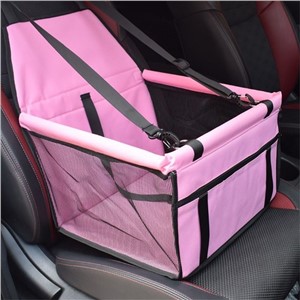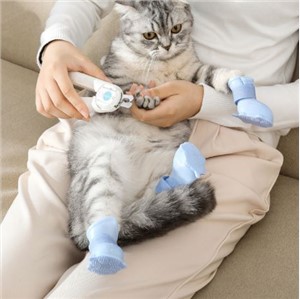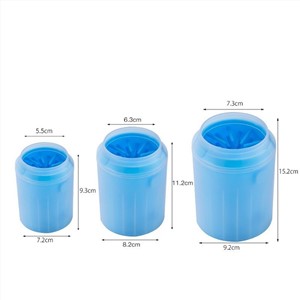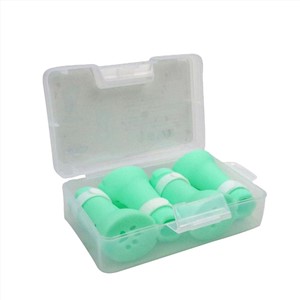Company advantages
Our certificate
Bonzer Pet quality management system has been certified by ISO9001:2000 and ISO9001:2008 as well as the national military standard GJB9001-2001A.
Competitive Price
We offering a higher-quality product or service at an equivalent price. As a result we have a growing and loyal customer base.
Customized Services
We understand that each customer has unique manufacturing needs. That's why we offer customization options to cater to your specific requirements.
24h Online Service
We try and respond to all concerns within 24 hours and our teams are always at your disposal in case of any emergencies.across borders.
What is Pet Shoes
Pet shoes are socks or shoes for dogs used to protect their paws against everything from hot pavement, rough surfaces and glass in summer, to snow, salt and freezing temperatures in winter.There are dog booties developed specifically for different purposes and conditions. In this guide we will go through different types of dog booties, how to use them, as well as how to measure and fit them.Dog shoes have become an important part of a pup's life to save them from seasonal hazards and protect their paws. We have discussed the essential benefits of dog booties for different seasons to educate pet parents.
Benefits of Pet Shoes
To warm up cold feet
Dog owners love their dogs. That's why they buy them dog boots. These shoes are designed especially for people who have pets. Dogs need special footwear to protect their paws from cold, wet ground, sharp stones, and ice. In wintertime, the temperature outside is always below freezing point. But, if your pet walks around barefoot, the feet can become frostbitten. So, you should provide him some protection from the elements. Dog boots are specially designed to keep the feet warm and comfortable.
To prevent injuries
Dogs can get hurt easily. Their paws may slip off a smooth surface or fall between two objects. If a dog's paw gets caught in these situations, he might experience injury. Therefore, dog boots help protect the feet from getting injured. Besides, they make walking easier for the dog. He does not have to worry about slipping off anything while walking.
To give your dog a longer life
Dogs live much longer than humans. Many breeds of dogs could live until 18 years old. There are several reasons for this. First of all, they have less body fat than us. Most of our bodies consist of water, and we lose water faster than our dogs do. Secondly, they eat healthier food than most animals. And lastly, they don't drink as often as we do; they only need to pee once every 2-4 hours. When they urinate frequently, it dehydrates their bodies. All of those things add up to a shorter lifespan for our furry friends.
To help heal wounds
Wounds are painful and sometimes dangerous. Wounds happen to dogs all the time. Sometimes they are caused by accidents, but they can also be caused by disease or even genetic issues. Because a dog's skin is thinner than ours, it's easy for him to suffer from cuts and abrasions. It can lead to infections infection. This is why dog boots are good for him. They help heal his wounds fast, keep bacteria out of the wound and help treat infections.
To help stop bleeding
The pads of a dog's toes are sensitive and sensitive to pain. When he steps on something hard, he feels it right away. His pads begin to bleed. If the dog is running at top speed, the blood flow increases and causes bleeding. Dog boots help prevent this from happening. They're made of durable materials that won't tear or rip. Plus, they are soft enough to cushion your dog's foot and help him walk comfortably.
To protect from ticks
Ticks are tiny insects that carry Lyme disease and other harmful illnesses. Ticks transmit diseases by biting the host mammal. They attach themselves to the host's skin and suck its blood. When a dog goes hiking in the woods, he can potentially encounter ticks. Dog boots, however, help protect him from coming into contact with ticks. Ticks cannot survive in the boot, therefore, they don't bite you while wearing them.
What are the Applications of Pet Shoes
Protection from Extreme Temperatures
Dogs' paws are sensitive, and they can suffer from extreme temperatures. In scorching summer, pavement and sand can become scorching hot, leading to painful burns on their paw pads. On the flip side, during the winter, icy and snow-covered surfaces can cause frostbite. The best pet shoes act as a barrier against these temperature extremes, ensuring your pet's paws stay comfortable and safe. There are pet shoes for winter and pet shoes for summer available in the market to cope with extreme temperatures.
Preventing Injuries
Sharp objects, broken glass, and other debris can lurk on paths and trails. Without proper protection, your dog is at risk of stepping on something that could result in painful injuries, infections, or even surgery. Pet shoes provide a protective layer, minimizing the risk of cuts and injuries.
Traction on Slippery Surfaces
Slippery surfaces like tile, hardwood floors, and wet grass can be challenging for dogs to navigate, leading to accidental slips and falls. Non-slip dog shoes with rubber soles offer better traction, providing your furry friend with stability and confidence, whether they're indoors or outdoors.
Allergen and Chemical Protection
Certain allergens, like pollen or lawn chemicals, can irritate your dog's paws. Shoes designed for dogs can act as a barrier, preventing these irritants from making direct contact with their skin, and reducing the likelihood of allergies or skin issues.
Post-Surgery or Injury Support
If your dog has undergone surgery or is recovering from an injury, shoes can aid in the healing process. Pet shoes protect the affected area and provide stability, preventing further damage while your dog regains strength.
Hygiene
If you and your dog enjoy outdoor adventures, you're likely familiar with the post-adventure paw-cleaning ritual. Pet shoes can help minimize the dirt, mud, and grime your pet brings home. This not only keeps your house cleaner but also >maintains your dog's hygiene.
Fashion and Style
Pet shoes come in various styles and colors, allowing you to express your dog's personality or coordinate their footwear with your own. It's a fun and fashionable way to accessorize your furry companion.
Types of Pet Shoes
All-Weather Boots
These boots are suitable for rainy, snowy, or muddy conditions. They usually have waterproof material and a good grip to prevent slipping on wet surfaces.
Waterproof Shoes
Ideal for dogs that spend a lot of time outdoors or in wet environments, waterproof shoes protect paws from getting wet and cold.
Protective Boots
Designed to shield pets' feet from sharp objects, rough terrain, or hazardous materials, these boots are reinforced with durable materials.
Heavy-Duty Boots
For dogs that work or hike in rugged terrain, heavy-duty boots offer maximum protection against thorns, rocks, and other potential injuries.
Reflective Shoes
Featuring reflective strips, these shoes enhance visibility in low-light conditions, keeping pets safe during evening walks or in poor lighting situations.
Boots with Soles
Some boots have rubber soles for added traction and support, which can be especially beneficial for dogs with arthritis or those recovering from injuries.
Adjustable Shoes
These shoes come with straps or Velcro that can be adjusted for a snug and secure fit, accommodating a range of foot sizes and shapes.
Boots with Non-Slip Soles
Designed to provide stability on slippery surfaces, non-slip soles are essential for pets walking on ice, wet floors, or smooth tiles.
How to Choose Pet Shoes
Size
A firm but comfortable fit sized properly for your dog's paws is essential for the booties to work well. Different manufacturers may have different sizing scales, so always measure your dog's paws carefully for the proper fit.
Adjustable Fit
Because a dog might have one paw that is slightly larger or smaller than others, dog booties with an adjustable fit are often best. This will allow you to be sure each paw is properly protected and the booties are secure.
Ease of Use
Take note of how easy it will be to put on or take off the booties to be sure you can use them comfortably without causing any stress or anxiety to your dog, but your dog should not be able to kick or shake them off easily.
Material and Construction Quality
Pet shoes are available in all types of materials, from vinyl rain booties to flannel winter socks to rubber galoshes. Choose the materials that work best for your pet and your climate, but be sure they are durable and well-constructed.
Sole Quality
A textured, rugged booty sole will be the most durable and provide the most traction for your dog. Consider your dog's typical walking surfaces and weather conditions to choose booties with the best sole for your pet's needs.
Color
Pet shoes are available in a range of colors and fashionable prints, but the color of the booties is about more than just style. The best booties will be bright, visible colors and will have reflective strips or accents for even more visibility.
Temperature Protection
Good quality pet shoes will provide temperature protection for both high and low extremes to keep your dog's paws safe from heat and cold. Different booties provide different levels of insulation.
Water Resistance
Most pet shoes will provide some protection from water, but there is a big difference between walking across a wet lawn, splashing through an occasional puddle, or wading in a creek. Choose water resistant or waterproof booties based on your dog's needs.
Price
Pet Shoes are available for every budget, but it is best to choose the most expensive, highest quality booties that can fit your budget. Consider all the footwear's features, but don't feel pressured to pay for more expensive booties than your dog needs.
How to Maintain Pet Shoes
Cleaning and Storing your Pet Shoes
It's crucial to clean the winter boots right after your walk. Clear off any snow, ice, and salt, as these can break down the material over time. Most dog boots can be hand-washed with a mild detergent.When storing your winter dog boots, keep them in a dry place out of direct sunlight. Direct sunlight can degrade the materials. Also, make sure the boots are thoroughly dry before storing them. Put paper or fabric stuffed inside to help them hold their shape.
Regular Checks for Wear and Tear
Regularly checking your winter pet shoes for wear and tear is crucial for ensuring they still provide ample protection. Examine the boots for any damage, such as rips, tears, and holes. Pay close attention to the bottom of dog shoes since they're in contact with sharp objects and slick surfaces often.Furthermore, worn-out soles can become slip soles, posing a risk for your dogs on icy or slippery surfaces. Skipping this step can lead to discomfort, injuries, and frostbite if your dog steps on something sharp or cold.
When and Why to Replace Your pet shoes
As a dog owner, you need to know when to replace your pup's protective boots. The tell-tale signs for replacement are usually when the boots no longer provide a snug fit or when they’re showing significant signs of wear and tear. If the boots are not as waterproof as they used to be, this is an indication that it's time to upgrade.Keeping your dog's feet dry is crucial in cold climates to avoid frostbite. Using sturdy winter dog boots is an excellent way to prevent snowballs from sticking between the pads or fur on your dog's feet!
How to Get Your Dog Comfortable With Wearing Shoes
Step 1
Make sure that the shoes are snug (but not too snug!). The key to a comfortable and secure shoe is the proper fit. To do this, you need to measure the widest point of your dog's paw. Have your dog stand on a tape measure to get an accurate width—her paws will spread a bit when she is standing. Compare this measurement to our size chart to select the correct size. If the shoe fits too snugly, it could rub against your dog's dew claw or pinch her sensitive paw pads. If the shoe is too big, it could easily slip off or chafe her skin as she walks.
Step 2
Once you have selected the appropriate size, it's time to try them on! First let your pup sniff the shoes and get familiar with them. Once she is comfortable, toss her a treat and loosen the shoe's hook and loop closure and ankle cord. Feed her another treat after you attempt to slide her paw into the shoe. Don't give up, it may take a few tries! If your pup is uncomfortable at first, remove the shoe and try again later.
Step 3
After you successfully fit one shoe onto your pup, you should be able to feel the tips of her toes near the front of the shoe. Pull and secure the hook and loop closure and cord tightly so that the top part of the shoe will not shift. Make sure you reward your dog with plenty of treats and belly rubs as you successfully put her shoes on one-by-one. If your pup is having trouble adjusting to the shoes, try just two paws at a time. It will help if you let your dog walk around the house before going outside as well. You can even leave a trail of treats around the room to distract her from the feeling of wearing the shoes.
Step 4
Feel free to take your pup on a short walk after she masters walking around the house in them. Slowly graduate to longer and longer walks as she gets more comfortable. Don't forget to praise and give her plenty of treats for the great work!
Our factory
BONZERPET Was established in 2017. Our company is located in Hangzhou, two hours' drive from Shanghai and Ningbo port. Since then, We always specialize in producing all kinds of pet products. And we have achieved a rapid growth in pet business now.Our main products are included pet bed, pet clothes, pet toys and cat tree in our own factory. Now we have over 100 workers and 6000 square meters area. The production capability reaches 50pcs 40ft containers per month. On another way, we also do trade business of all kinds of other pet products. They are included pet collar & leashes, pet brushes, pet feeders, cat toys, small animal accessories, bird and fish accessories.
FAQ
Is it good for dogs to wear shoes?
Shoes can help protect dogs' paws from injuries caused by sharp rocks, thorns, and other hazards in the environment. They can also provide extra protection against burns, cuts, and other injuries. This makes them a good option for dogs that spend a lot of time outdoors.
What do vets think of dog shoes?
“Generally, dog boots will not cause your dog any pain, however, they might feel uncomfortable, which is why I advise against purchasing them. Dogs find it extremely difficult to adapt to wearing boots, as they make their paws heavier and restrict movement.
Can I get shoes for my dog?
Keep their paws safe, warm, and protected with dog footwear from this varied collection. Dog booties help prevent injured pads from infection. What's more, they can help keep their paws dry in wet weather, warm on cold days, and safe from hot roads in the summer.
What kind of shoes does a dog wear?
Dog boots and dog shoes are a great way to help protect paws in cold weather, in hot weather, and on rough terrain. For dogs that join their humans walking, running, hiking, skiing, and everyday exploring, boots can help protect paws from getting things like cuts, burns in hot weather, or frostbite in cold weather.
Do vets recommend dog boots?
If your dog struggles with walking, they may appreciate some vet-recommended, extra-grip, non-slip orthopedic boots. This can help dogs with arthritis, hip dysplasia, and other conditions.
Is it OK to put socks on dogs?
Socks are unnatural to a dog and makes it hard for a dog to navigate, especially on smooth surfaces. A dog would spend most of his or her time chewing them off and perhaps eating them, which would cause potential life threatening blockages in the bowel that might require surgery.
How long can dogs wear shoes for?
Do not leave shoes on your dog for long periods of time (more than 5 hours) as the heat may cause discomfort and irritation to your dog.Swimming. If your dog loves to swim, consider buying a pair of water shoes that have a traction sole. They can help protect your dog's paws from sharp rocks or other hazards in the water, and they're best for protecting your dog's feet from seagrass, rocks, and other debris on the beach.
Why do dogs prefer shoes?
For one thing, shoes are easily accessible. They're usually found at ground level, making it easy for a dog to case the scene, grab the shoe, and sprint off. From there, shoes become a kind of sensory experience. They have their owner's scent as well as smells that have been transported from walking in other areas.
Can I put socks on my dog to stop licking?
Socks can be applied to your pet's paws to be a barrier against chewing or licking excessively at the paws. The sock should extend far enough up the leg to cover the affected area, but not farther than halfway up the leg.Your dog's feet get hot and sweaty inside dog boots or socks. Since dogs sweat through their paws, socks don't allow your dog's paws to breathe. 4. A dog may chew at the dog booties or socks because they are covering and touching the dog's paws and toes—sensitive tissue.
At what temperature do dogs need shoes?
In cold weather, dogs can suffer from frostbite on their paws if they are exposed for prolonged periods. Different dogs have different tolerance levels, but a good guideline is to consider using boots as winter paw care when temperatures dip below freezing or if there is ice, snow, or salt on the ground.
Do dogs like shoes on their feet?
Their paw pads have a high number of nerve receptors that provide sensory feedback about the ground they're walking on - its texture, temperature, and so on. Wearing boots can interfere with this sensory input. However, this doesn't mean that dogs cannot get used to wearing shoes or find them comfortable over time.
Why do dogs like leather shoes?
Leather is one of the most popular types of shoes to chew as it smells and tastes good since it's made of cattle hide. Chewing on leather is enjoyable for your pet because it softens and becomes tastier the more it get chewed on.
What is an alternative to boots for dogs?
If your pet will mostly use paw protection indoors, we recommend a Cushy-Paw Slipper instead. Slippers allow the paw to breathe and can be left on throughout the day while the pet is indoors. Slippers are padded and will protect and comfort your pet's paw.
Do dogs need shoes for hot pavement?
Some geographic areas — particularly sunny locations with high temperatures and paved ground — make walking very difficult in the summer months. In these terrains, dog shoes or booties are beneficial. Your dogs breed, size or age don't influence their need for paw protection.On cold, rainy days, it can get pretty cold out there. Like us, heat from our dogs' bodies escapes from their paws, so keeping them dry and warm becomes even more important when it's chilly outside. Doggie rain boots are the perfect solution to keep your dog's sensitive paws dry and safe from the chilled air.
Is it OK for my dog to wear clothes?
There's no right or wrong answer, as long as you're not doing any harm. You know your dog's temperament better than anyone. If they have the patience and don't mind an occasional fashion show, go for it! Many dogs enjoy the extra attention.
Why do dogs walk funny in boots?
Dogs rely on constant feedback from their foot pads to tell them everything from how fast they're walking to exactly what they're standing on. So when that signal (called proprioception) is blocked by socks, a bandage or even protective boots, they assume the worst and think their foot is stuck.
Can dogs feel cold in their feet?
Ice and snow can stick to the fur between their pads and ball-up. Not only could this be uncomfortable for your dog, but it also increases their risk of frostbite. If your dog lifts their paws, stops walking or whines it could be a sign that their paws are too cold.
Is it OK to give a dog an old shoe?
Make unacceptable chew items unpleasant to your puppy. Furniture and other items can be coated with Bitter Apple to make them unappealing. Don't give your puppy objects to play with such as old socks, old shoes or old children's toys that closely resemble items that are off-limits.
Can dogs wear socks and shoes?
Some dogs may object less to socks than they do to boots. Socks can work for short walks to provide protection from the temperature of the ground, but they aren't the best for outdoor adventures since they don't stay in place for long.Your dog may lick you to say they love you, to get your attention, to help soothe themselves if they're stressed, to show empathy or because you taste good to them!
Can dog wear socks overnight?
Can I leave socks on my dog overnight? Leaving the sock on during the night should not be such an issue. Then keep off during the day to allow more air flow to the paws too. Another option can be an Ecollar too, this can allow to not scratch the ear too with not having to keep the paw always wrapped.Rubbing her belly activates the nerves under her skin, which are connected to her spinal cord. In nature, this stimulation is what relays the message to the brain for her to kick her legs to get rid of whatever is activating her nerves, which in nature would most likely be insects or some other irritant.

Pet shoes and socks outdoor sneakers non-slip soft silicone large dog shoes Golden fur Teddy dog shoes and dog shoes and socks
Read More
Dog shoes waterproof non-slip wear-resistant outdoor dog rain shoes pet nail clipping anti scratch cat shoes wholesale
Read MoreSilicone cat foot cover pet supplies cat bath magic pet shoes foot cover gloves wash cat bag wash cat bag
Read More
Pet foot washing cup dog cat bath magic pet cleaning and grooming go out to wash PAWS automatic foot washer
Read More
The manufacturer's new pet foot cover for 4 cat bath anti-scratch foot cover silicone anti-claw cover cat holding cat feeding medicine injection
Read More